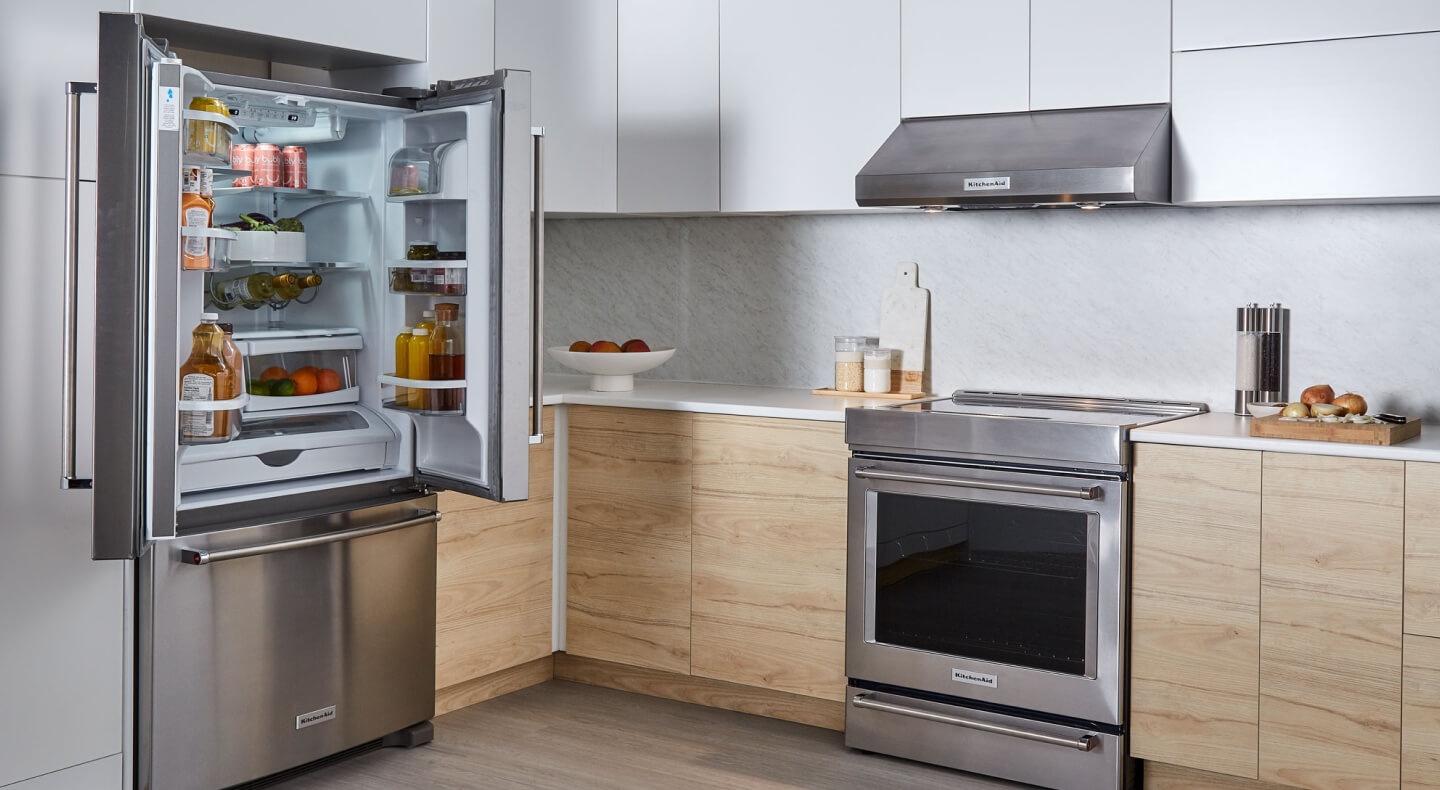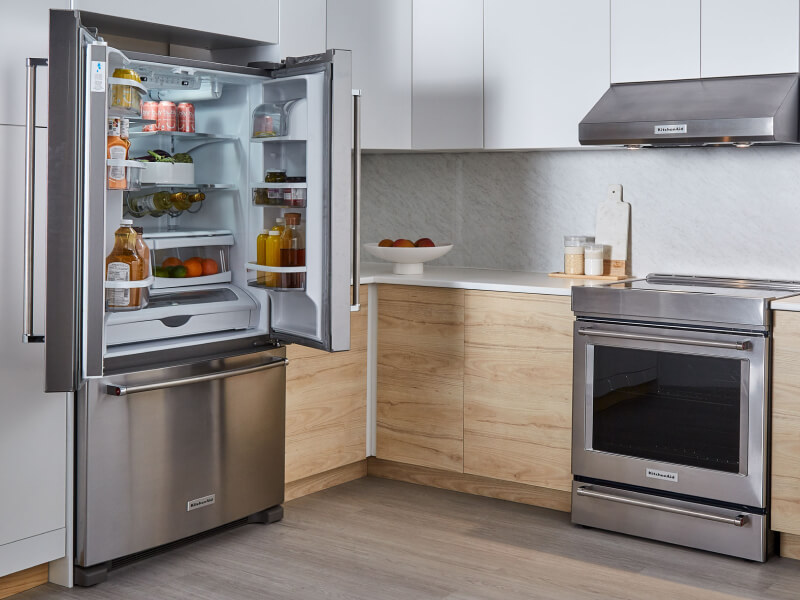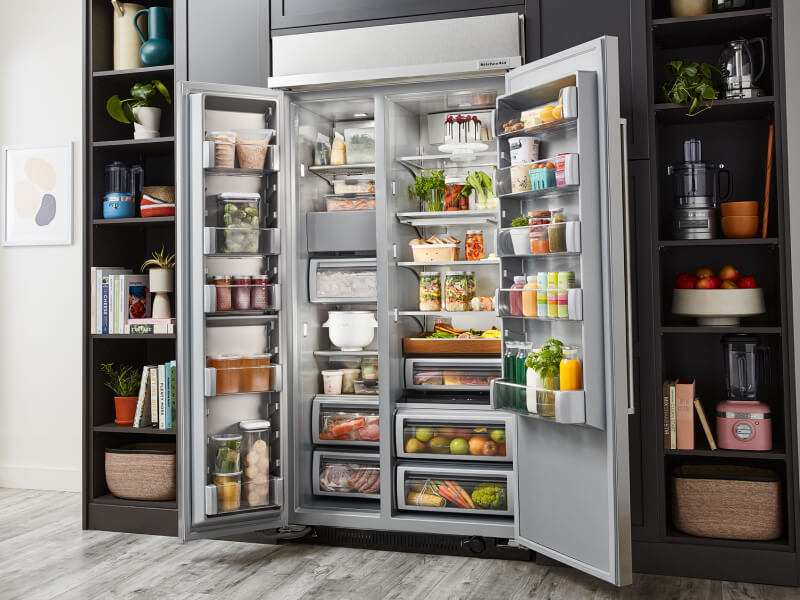
Refrigerator troubleshooting
Your refrigerator is one of the most utilized appliances in your kitchen, so when something goes wrong, it can put a pause on your creativity until you can solve it. You may be able to troubleshoot some of the possible issues that can arise with your refrigerator. Read this guide to learn how to troubleshoot possible refrigerator problems and get your fridge back to chilling your homemade cheesecake or freezing your freshly made sorbet.


What is the first thing to check when a refrigerator stops working?
First, check your owner’s manual for troubleshooting advice and solutions to problems that may arise with your refrigerator model. Then, check the power source. Make sure your refrigerator is plugged in and the outlet is working properly. If other items in the same outlet are working, there may be a problem with your refrigerator.
Possible refrigerator problems and how to fix them
From leaky water lines to freezing food to warm temperatures, it's important for homeowners to know what possible refrigerator issues look like and explore ideas on how to repair them. Many refrigerator problems aren't as complex as they seem at first glance, but some can be tricky. If you aren’t sure how to diagnose or solve your refrigerator’s issue, you should call a professional. Read more about the possible problems and solutions below.


1. Refrigerator not cooling
If your refrigerator is not cooling, you may want to troubleshoot and remedy the issue as soon as possible so your food doesn’t spoil. The solution could be very simple.
Potential solutions
- Ensure your refrigerator is in a location where the temperature is within the recommended range. Operating the refrigerator outside of the recommended temperature range may result in improper internal temperatures and temperature fluctuation.
Check that the power cord is connected to the outlet and the power supply is on. You may also need to check the fuse that services the refrigerator.
It's recommended to check if the condenser coils require cleaning. Generally, routine cleaning of the condenser is not necessary. However, if the surrounding area is excessively greasy or dusty, or there are pets around the house, you should clean the condenser every 2-3 months. For detailed instructions on how to clean the condensers for your particular refrigerator model, please refer to the owner's manual.
Ensure that the cooling function is turned on. Depending on the refrigerator, you may need to manually turn it back on after a power outage or power surge. The refrigerator could also accidentally be turned off during routine cleaning.
Temperature controls are typically preset at the factory to the "mid setting" which should be correct for normal household use. The controls are set correctly when beverages are as cold as you like.
Give your refrigerator about a day after installation to get to the right temperatures. During installation, you should also make sure nothing is getting in the way of the door sealing when closed such as packaging or interior bins and shelves.
Adding a large amount of food or beverages to the refrigerator warms it. It can take several hours for the refrigerator temperature to stabilize after adding a large number of warm items.
Try to get everything you need out of the refrigerator at once, keep food organized so it is easy to find and close the refrigerator as soon as the food is removed.


2. Refrigerator door doesn’t stay closed
If your refrigerator doors are not staying closed, this can be an easy adjustment. You can troubleshoot and potentially fix this problem yourself.
Potential solutions
It is important to ensure the refrigerator is level for numerous reasons, but if one door is opening when the other is closed, check that the doors are level. Refer to your owner's manual or installation instructions for specific leveling information for your refrigerator.
The gasket requires regular cleaning for the doors to open and close properly. Dirt and other particles can build up on the gasket surface and cause resistance or an improper seal. Check the door gasket regularly to ensure it is clean and free of food particles.
Ensure that food packages or improperly installed shelves are not keeping the door from closing.
- If your refrigerator was recently installed, make sure all packaging has been removed.

Need help finding a new refrigerator?

Compare counter- vs. standard-depth


3. Refrigerator is leaking or collecting water
A leaky refrigerator can cause damage to your flooring and other issues. If you notice water on the floor near or under your refrigerator, or water has pooled inside your refrigerator, there are a few potential solutions that might help.
Potential solutions
If water appears to be leaking from the back of the refrigerator, make sure the water line from the household water supply to the refrigerator is not damaged or cracked. If it is, shut off the water supply to your refrigerator.
Check all connections that are accessible, such as the connection at the supply valve and the connection point of the supply tubing onto the back of the refrigerator. Make sure the tubing is firmly inserted into all fittings and all fittings are tightened.
If you’re unable to determine the source of the leak, consult a professional.


4. Refrigerator is making noise
A slight hum coming from the refrigerator is normal and not cause for alarm in many instances. However, some noises may indicate an issue that requires your attention.
Potential solutions
Grinding or squeaking may mean the doors are rubbing against cabinets or other surfaces when opening.
Rattling or vibrating sounds may be the flow of refrigerant through the cooling system, or water through the water line. It could also be items on the top of the refrigerator or an issue with the refrigerator’s leveling.
A gurgling sound can be indicative of refrigerant flowing through the tubes after a cooling cycle.

KITCHENAID® REFRIGERATORS
Refrigerators that inspire your creativity
Shop built-in, freestanding and specialty KitchenAid® refrigerators with versatile features and high-end details crafted for your kitchen


5. Refrigerator has an odor
If your refrigerator has an odor, it might affect the taste and quality of your food. Most odors can be eliminated with basic cleaning. Make sure that you routinely clean the interior of the refrigerator to help prevent a build up of odors and smells.
Potential solutions
Keep foods tightly wrapped or covered
Wipe spills immediately
Clean all sections about once a month
Keep your refrigerator and freezer well-organized, including crisper drawers so you may not overlook expired foods
Discard any spoiled or rotten food
Routinely clean under the refrigerator, removing any dirt or items that may be trapped under the refrigerator.
Select models come with an air filter which is typically more powerful than baking soda at reducing common food odors inside the refrigerator. If your refrigerator has an air filter, regularly replace the filter based on the indicator tab.


6. Refrigerator ice maker is not working
You probably rely on your ice maker to make fresh cubes for your favorite cocktails or your morning protein shakes, so it needs to be in good working order. If your ice maker is not working properly, there are a few things you can check.
Potential solutions
A buzzing sound may indicate the ice maker is not connected to a water supply. For more information, check out this article on troubleshooting your ice maker.
- Ensure the ice maker is turned on
Double check that the ice maker is not jammed
Replace the water filter
Flush the water system
Check water supply line


7. Refrigerator water filter damaged or leaking
It is recommended that the water filter be replaced every 6 months when the indicator light comes on or as needed. A clogged or incorrectly installed water filter can reduce the water flow to the ice maker and dispenser and could cause a variety of problems.
Potential solutions
Dispense water using the water dispenser and note the amount of water flow. Remove the filter. Dispense water with the filter removed. If the water flow noticeably increases, the filter may be clogged or incorrectly installed. A clogged filter will need to be replaced in order to correct the low flow.
Replace your water filter, if necessary.
Flush the water system after replacing the filter.


8. Refrigerator light turning on
The light inside the refrigerator is helpful for finding items you need. If the refrigerator light is not turning on, try one of the solutions below.
Potential solutions
On some refrigerator models, if the doors have been opened for a certain period of time, the interior lights will automatically turn off. To reset the lights, close all the doors.
The interior lights in your refrigerator are usually controlled by the door switch. This switch is activated when the door is opened and closed. If the switch is not engaged properly, it may cause the interior lights to remain off. The door switch location varies by model number, but in most refrigerators, it is typically near the top or bottom of the door opening. To ensure proper door switch contact, check the following:
The refrigerator is level and doors are properly aligned
Ensure there are no magnets or electronic devices within three inches of the door switch.
If the refrigerator was recently moved or installed and the doors were removed, check to make sure the wiring plug is properly connected. Don’t forget to unplug the refrigerator or disconnect the power before checking.
Sabbath Mode may be activated. Sabbath Mode is designed for the traveler or those whose religious observances require turning off the lights. By selecting this feature, the temperature set points remain unchanged, but the control panel lights, interior lights and control audio turn off. Follow the instructions in your owner’s manual to deactivate Sabbath Mode.
Many new refrigerators are equipped with LED light bulbs that do not need to be replaced. If your refrigerator or freezer compartment has a traditional light bulb, check to see if the light bulb is loose in the socket and tighten it if needed. If the bulb needs replacing, be sure to use an appliance bulb of the same size, shape, and wattage (no greater than 40 watts). Consult your owner’s manual for more information.
How do I level my refrigerator?
First, check to make sure the floor under the refrigerator is level. If the floor is not level, shims can properly level the refrigerator. Next, open the refrigerator doors to 90 degrees and remove the base grill. Close the doors to help stabilize. Then, with the help of a friend, follow the instructions in your product’s manual to adjust the leveling feet located on the brackets using a ¼ inch open-ended wrench. Each leveling foot can be raised or lowered independently.
A refrigerator that is not leveled correctly or does not have the doors properly aligned could have issues with doors closing properly, frost build-up and moisture problems, temperature fluctuation, vibrations and noise, among other problems.

MULTI-DOOR REFRIGERATOR
Plenty of room for fresh and frozen fruits
Keep your favorite fresh and frozen foods organized just the way you like with this multi-door French door refrigerator
What temperature should my refrigerator be at?
37°F is the factory setting on KitchenAid® refrigerators. It’s important to remember that different zones have different temperatures. You can read more about refrigerator temperatures in this guide.
For instance, things like chutney and almond butter are best kept in the door compartments since these sections experience more temperature fluctuations when opening and closing the door. Meat and dairy should be stored in the bottom shelf or back of the fridge since they tend to be the coldest spots.
Is there a reset button on the fridge?
Although there is no reset button on most refrigerators, it is still possible to reset a refrigerator manually. Try the following steps:
Power it down by turning off the circuit breaker or unplugging the refrigerator for 5 - 10 minutes.
Power the refrigerator on by turning on the circuit breaker or plugging it back in.
Ensure the cooling function is turned on.
Preventative fridge maintenance tips
Proper care and maintenance of your fridge is essential to keeping it running smoothly. Read below for some preventative steps you can take to help ensure your refrigerator stays in good condition and your food stays fresh.
1. Clean the interior
Cleaning the interior of your fridge monthly can help keep the refrigerator and freezer organized and free of spoiled or expired food. It can also help remove and prevent odors from forming. Hand washing with a mild detergent is recommended. Don't forget to clean the bins and rails.
2. Change the air filter
Changing the air filter in your refrigerator every six months can reduce common food odors inside the refrigerator. Air actively passes through the filter, helping to neutralize odor and sometimes bacteria, so a fresh air filter can help ensure a fresh refrigerator.
3. Clean the condenser coils
It is recommended to clean the condenser coils once per year to help keep your refrigerator running smoothly and remove build-up from the coils. Refer to your owner's manual for specific instructions for your model.
Not all condenser coils need to be cleaned. Refer to your owner's manual for specific instructions for your model.
4. Inspect door seals and gaskets
Once a year you should inspect the door seals and gaskets of your refrigerator to help keep your refrigerator in good working condition and to help prevent frost or condensation build-up from air leaks. You should also check the door seals on your freezer to avoid problems with the freezer not freezing and to keep the appliance running properly.
Shop KitchenAid® refrigerators
Whether you are in the market for features that do more than keep ingredients cool or craftsmanship that delivers timeless yet modern fits, feels and finishes, KitchenAid brand has a refrigerator for you.

KitchenAid® Hardware Accessory Kits
Curate the colors and textures that move you
From bold Black Ore to the inviting warmth of Bronze, mix and match handles and knobs to refresh your appliances and bring new energy to your kitchen

